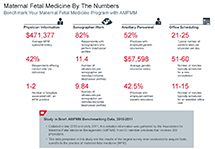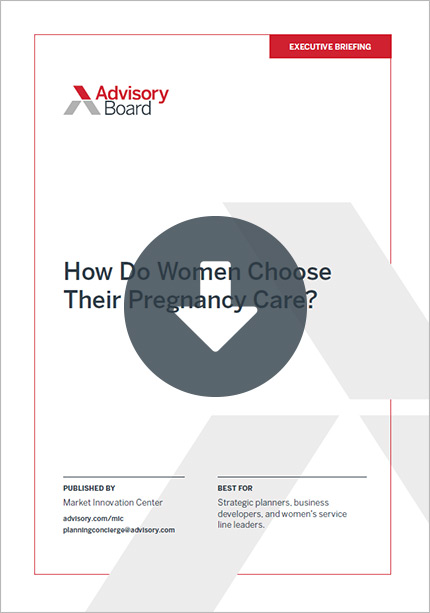Auto logout in seconds.
Continue LogoutMaternal mortality rates in the United States vary widely by states, with Louisiana having the worst and California having the best rates, according to a USA Today analysis.
Previous investigation spotlights shortcomings
The analysis draws on data from a USA Today investigation published earlier this year that identified birth rates in 2016 as well as death rates from 2012 to 2016.
The 5 top questions executives should ask themselves about maternal mortality
USA Today obtained over 50,000 pages of internal hospital quality records through federally funded quality programs from dozens of hospitals in 2015 and 2016. USA Today also received comments from 37 birthing hospitals.

Maternal fetal medicine by the numbers
Overall, the investigation found "a stunning lack of attention to safety recommendations and widespread failure to protect new mothers." It also found that many doctors and nurses were not completing "basic tasks" such as tracking blood loss by weighing bloody pads or giving women blood pressure medications within hours of detecting high blood pressure levels to prevent strokes, which experts recommend to keep women safe during childbirth.
The best and worst states for maternal mortality
Using the data gathered in their investigation, USA Today ranked the states with available data on maternal mortality.
The analysis showed maternal mortality rates varied widely by states, ranging from a low of 4.0 deaths per 100,000 births in California to a high of 58.1 deaths per 100,000 births in Louisiana.
The five states with the lowest maternal mortality rates were:
- California;
- Massachusetts;
- Nevada;
- Connecticut; and
- Colorado.
The five states with the highest maternal mortality rates were:
- Louisiana;
- Georgia;
- Indiana;
- Arkansas; and
- New Jersey.
What the top states are doing
USA Today profiled what different states are doing to fight maternal mortality.
For example, in California state health officials published two in-depth reports on the state's maternal mortality rates, one in 2011 and another in 2018. The reports looked at specific failures by doctors and hospitals and recommended ways to improve maternal care. The report found that, from 2002 to 2003, 75 out of 98 deaths involved medical failings including "delays or inadequacies in diagnosis or treatment."
In Massachusetts, officials have had a maternal death review in operation for over two decades. In 2014, the maternal death review panel recommended that every hospital set guidelines on treating maternal hemorrhage. The panel also published a 2014 report that looked at maternal deaths from 2000 to 2007 and focused on both social and medical issues related to those deaths.
Connecticut also launched maternal death review panel in 2015, and so far has published one report on the panel's findings. Initially, the panel was a partnership between state government and a private medical society representing the interests of providers, but a new law enacted this year created an entirely state-run panel tasked with conducting a comprehensive, multidisciplinary review of maternal deaths in the state.
What hospitals can do
As U.S. maternal mortality gains attention in the media, a group of physicians in a recent essay in the New England Journal of Medicine outlined actions hospitals can take to "reverse the devastating trend in pregnancy-related deaths."
The authors offer four steps for hospitals:
- Increase the focus on preventable causes of maternal complications by adopting "bundles" of best practices for safety in maternity care;
- Hold multidisciplinary staff meetings to assess and review patient risks, such as hemorrhage-risk level per guidelines developed by the California Maternal Quality Care Collaborative;
- Simulate obstetrical emergencies to increase team preparedness; and
- Use the Maternal Health Compact, which "ensures readiness by formalizing existing relationships between lower-resource hospitals that transfer pregnant women when they require higher levels of maternal care and the referral hospitals," the authors wrote.
The authors identified three common childbirth complications that hospitals can address:
- Blood clots before or after delivery;
- High blood pressure; and
- Postpartum hemorrhage.
Kimberlee McKay, one of the essay authors, a professor of obstetrics and gynecology at the University of South Dakota, and head of obstetrics at Avera Health, said communication is key to fighting maternal mortality. Once a change in a patient's status is noticed, it needs to be communicated to other team members, then a plan has to be made and everyone has to be held accountable to that plan.
McKay added that her team does drills to work on recognizing common childbirth complications.
In addition, McKay said reducing maternal mortality requires commitment from hospital administration. "It takes not just the desire of the people providing the care … to do a better job. It takes the commitment of the administration to say we're going to invest in this," she said. "A huge piece of this investment is taking a really hard look at your culture. It's time, it's cost, and it's a great deal of dedication. You've just kind of got to hunker down and do it" (Ungar/Simon, USA Today, 10/26; Gordon, "Shots," NPR, 11/6; Mann et al., New England Journal of Medicine, 11/1).
Now open to all members: 9 elements of top perinatal patient safety programs
Perinatal care is a high-volume service, accounting for one-fifth of all hospital stays. Yet it is also highly variable, with significant differences in complication rates for both vaginal and cesarean deliveries between hospitals nationwide.
This toolkit is designed to help hospitals seize the opportunity to strengthen perinatal patient outcomes. It includes best practices and resources collected from organizations that have successfully improved labor and delivery care by reducing clinical variability.
Don't miss out on the latest Advisory Board insights
Create your free account to access 1 resource, including the latest research and webinars.
Want access without creating an account?
You have 1 free members-only resource remaining this month.
1 free members-only resources remaining
1 free members-only resources remaining
You've reached your limit of free insights
Become a member to access all of Advisory Board's resources, events, and experts
Never miss out on the latest innovative health care content tailored to you.
Benefits include:
You've reached your limit of free insights
Become a member to access all of Advisory Board's resources, events, and experts
Never miss out on the latest innovative health care content tailored to you.
Benefits include:
This content is available through your Curated Research partnership with Advisory Board. Click on ‘view this resource’ to read the full piece
Email ask@advisory.com to learn more
Click on ‘Become a Member’ to learn about the benefits of a Full-Access partnership with Advisory Board
Never miss out on the latest innovative health care content tailored to you.
Benefits Include:
This is for members only. Learn more.
Click on ‘Become a Member’ to learn about the benefits of a Full-Access partnership with Advisory Board
Never miss out on the latest innovative health care content tailored to you.

